What the fuck is Eurogamer smoking?!




There are moments in Dragon Age: The Veilguard where all I can do is stop and gawp. To see a fantasy adventure brought to life around me at such scale and with such drama is astonishing. I keep expecting the illusion to falter and for the game to tire but it never does. Always, the ante is upped and the centrepiece grows. I gawp. I hold my breath. I have never been on a BioWare ride like this.
Dragon Age: The Veilguard review
- Developer: BioWare
- Publisher: EA
- Platform: Played on PS5
- Availability: Out 31st October on PC (Steam, Epic), PS5, Xbox Series S/X
But around that is a game of surprising breadth and depth, one I hadn't necessarily expected. I feared it shallow but there's crunchiness to the role-playing systems. I feared it narrow but there's a magnificent world that yawns open as you play. It's as filling as any Dragon Age game before it and every bit an RPG, and yet, it's also more.
By pushing towards action game territory like Mass Effect before it, The Veilguard has realised a physicality and immediacy we've never seen in Dragon Age, and it's a freedom that's exhilarating. It pulls us closer to the world and the world-shaking events of the game - and what events they are. The Veilguard makes the Dragon Age games that came before seem trivial by comparison. The series has evolved. Dragon Age has never been this good.
Dragon Age The Veilguard Review: The BEST Bioware Has EVER Been! (Spoiler-Free)
Here's a video version of our Dragon Age: The Veilguard review.Watch on YouTube
We pick up events in The Veilguard 10 years after the story of Dragon Age: Inquisition ended, following new hero Rook on the path of our old frenemy Solas, the Inquisition companion revealed to be an ancient elven god at the end of that previous game. He's trying to tear down the barrier he created (the Veil) between the waking world and the dream world (the Fade), and in doing so cause a right old cataclysmic mess, so we're trying to stop him. You've seen this prologue in gameplay trailers before: Tevinter's capital Minrathous at night, in the rain, and a breathless descent down through the city as demons hurtle from the sky and chaos erupts around you.
Immediately, it's a statement of intent: this is how impressive Dragon Age: The Veilguard can look. Cinematic blends into helter skelter traversal, enlivened by now being able to mantle and contextually leap over obstacles, which then leads into combat with clusters of enemies, a sprinkling of dialogue, some meaningful choices, set pieces and boss fights. It's BioWare showing what the series' new mission-based approach can achieve - an approach we're more familiar with from Mass Effect. Scripted missions with designed routes can deliver incredible bombast. But can the rest of the game keep it up? Yes, in spades.
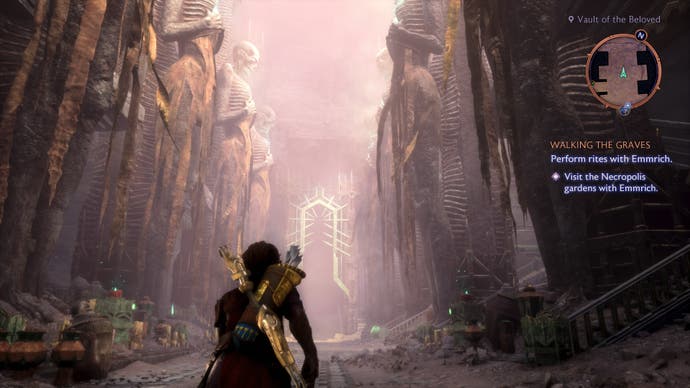

The variation between major locations is distinct and very welcome. | Image credit: Eurogamer / EA BioWare
I said it earlier but the sheer scale and exuberance of some of the major missions in this game is staggering. Even as soon as the end of the first act - there are, loosely, three acts - we experience the kind of blockbuster, 'everyone's here' showcases that other BioWare games have ended with, and somehow it just gets bigger from there. Huge bosses, huge moments, surprises, drama. And the ending of the game is an all-timer; it left my jaw on the floor. It trumps anything BioWare has done before, and that includes the renowned 'suicide run' from Mass Effect 2.
What I find even more impressive, though, is how these big moments are not reserved for the major story beats, but find their way into companion missions and even exploratory side quests. There's a generosity right across the game in this regard.
It makes The Veilguard capable of catching your breath wherever you go, even if it's on the smallest errand. Much of this is to do with the divisive new graphical style. BioWare has gone for a more stylised approach here, exaggerating features and smoothing textures, as though aiming for something closer to an animated film in appearance, and it really works. The exaggeration helps enhance facial gestures and draws out the inherent fantasy and emotion in scenes and environments.
The elven forest of Arlathan, for instance, radiates gold and green and shimmers with rainbow iridescence; Dock Town in Minrathous is slate grey and soaked in rain, puddles gathering between the cobbles; and wherever the Blight is, its sickness is palpable, black and rotten, punctuated only by pulsing, angry red spores. It's gross; it's beautiful. But the champion of it all is the lighting. There's not a scene in the game that isn't bathed in the glow of a coloured light, whether it's falling on a cheek or outlining a companion's concerned frown. No corner of the world is neglected and dull: everything is dressed, everything is lit, and it makes The Veilguard a sight to behold.
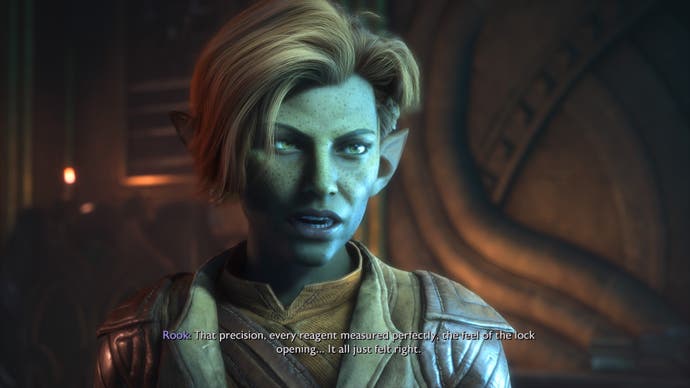

The lighting throughout the game is consistently sumptuous. It warms and colours the whole game. | Image credit: Eurogamer / EA BioWare
One thing that surprised me about The Veilguard was how open its world turned out to be. As you progress and new companions join you, they'll introduce you to a zone that houses a faction they belong to, in which there will inevitably be a merchant related to them, various people to talk to, and a larger exploratory area around it where various things can be done - big quests, small quests, environmental puzzles. There's a necropolis, there's the city of Treviso, there's the wartorn area of Hossberg Wetlands - there are many, you'll return to them repeatedly, and they are each distinct and varied.
They also house pick-up, incidental quests, but don't worry, lessons from Inquisition have been learned. Even when your tasks are at their smallest, they're never fetch-quests and there's an appreciable level of effort gone into them. Plus, as with everything in the game, there's an inherent and interconnected value in them, in everything you do, meaning no task is superfluous.
Each area being linked to a faction means everything you do there increases your rating with that faction, which in turn increases its strength, because you're doing things to help them - and this strength score becomes incredibly important later on. It also helps you unlock better gear at the merchant there, plus every quest you complete boosts your Bond score with whichever companions you're adventuring with, which controls their skill points and their loyalty to you, so there are multiple reasons to help out. Plus, many of the quests or environmental puzzles offer chests and rewards of their own, or extra skill points. I never felt short-changed or that my time was being abused or not rewarded in the game.
There's expertise in how it's all been put together too - lots of little moments of smart attention that make life much smoother for the player. The quests, for example, are often clustered in areas so you find other things to do when you get there, so you're not running back and forth. Fast-travel locations: there are bloody loads of them, and you can use them at any time, from anywhere, and they double as respawn points and places you can change your party from. Even tiny little things like ladders or ledges placed at the end of environmental puzzles, in a way that takes you back to where you were at the beginning of them, are pleasing to see. There's lots of thought and consideration, and experience, permeating through the game.
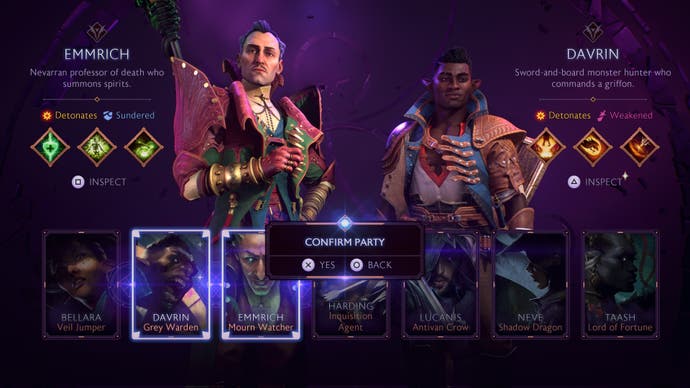

Companions have skill trees you can spend points in when you increase your Bond with them. | Image credit: Eurogamer / EA BioWare
Let's get onto more juicy stuff. There's a new roster of companions here and, just as in a game like Mass Effect 2 - a surprisingly accurate comparison, I'm pleased to say, after angling my preview of The Veilguard around it - you'll be sent out to gradually collect them. It's a relatively slow start with them, in terms of who's available from the beginning - I found the initial ensemble a bit twee and saccharine - but as characters like Lucanis and Davrin, and especially Emmrich and Taash arrive, the group dynamic improves dramatically.
In many ways it is a game about them, your companions. Through them The Veilguard speaks to our hearts, and it's how the game approaches complex topics from our own world - topics like gender identity, neurodiversity, personal trauma, and parenthood - and each is handled gently and unobtrusively, and with maturity and care. Romance is of course part of the game, but I'm pleased by how restrained it is here, and how it refocuses relationships on the emotional side rather than being about trying to bang someone. I flirted with everyone for hours before committing to Taash, but no one was giving anything away easily.
The companions in a BioWare game have never been so consistently present as a group as they are here. They have their individual homes around your Lighthouse base, as in other BioWare and Dragon Age games, which are lovely reflections of the characters in them, but they also move around to talk to other companions and in some cases, develop relationships with them. But whenever you debrief after something big, or whenever you plan for something big, you're all together, talking about it - not just some of you. It fosters a sense of togetherness, that you're all in it together, not some of you while others stand idly by. Incidentally, the game does still suffer from companions being stabled while others go out, so they don't level up as much, but game does what it can to alleviate this, such as enforcing companion choice on certain missions, encouraging using companions when exploring their home areas, and, at certain major points, it will make everyone's Bond score increase.
Of course there's a reason for this, and a reason why the game rather jarringly and fourth-wall-breakingly states - after the first act of the game - that you should focus on your companions now, despite the pressing urgency of world events, and its for reasons that will become clear during the final stretches of the game. The companion storylines offer their own rewards in the quality of them, then, but the payoff at the end of the game for your work here, or your lack of work here, magnifies this tenfold.
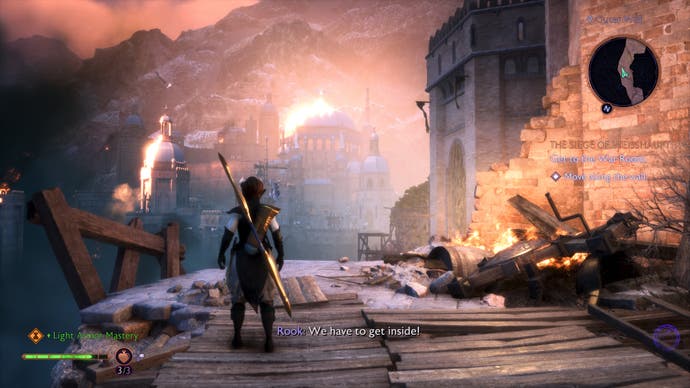

Each companion has their own part of your new base. Here's Davrin in his eyrie. Oh, and above, I play around with the built-in photo mode, to try and relay the sense of scale that's in the game. | Image credit: Eurogamer / EA BioWare
Unlike in other Dragon Age games, though, you cannot directly control your companions in combat, and you have limited ability to tinker with their equipment and abilities. As alluded to earlier, when their Bond score reaches a new tier, they'll get skill points you can spend improving their handful of abilities, and then in combat you can determine when they use them (as well directing their general attacks if you wish).
That doesn't sound like much, but there's a lot more other stuff going on in The Veilguard combat than has been in Dragon Age games before. It's an action game, really, a boundary the series has been pushing towards but never quite passed, always emotionally shackled, as it was, by its CRPG roots. But now it's stepped over, taking Mass Effect's lead as an example, and it's discovered something new and very successful as a result.
Each of three classes has, as standard, a light attack, a heavy attack, a ranged attack, a dodge and a block, and charged variations of some of them - a full suite of action game-like capabilities. BioWare knowing you have these means it can test you in ways the games haven't been able to do before (both in combat and out, I should add). In other words, it can come for you. The clusters of enemies the game throws at you don't give you moment's peace, regardless of where you are on the battlefield. I was predominantly a Rogue archer build so I'm speaking from experience, and whether it was enemies charging me or attacking from range, or teleporting next to me, I was always, somehow, from somewhere, under attack. Bosses, in particular, are incredibly aggressive, sometimes barely giving me time to draw my bow if under their glare. It makes combat extremely energetic and immediate, and bosses as terrifying as they should be, given the magnitude of the creatures you will take on.
Consider that and all of the dodge-rolling and parry-timing and sprinting around, and active aiming and button-press combos you're asked to pull off, and it's a blessed relief you don't have to micromanage companion combat. But it does mean combat can sometimes feel tough and relentless, especially when piled upon by multiple enemies at once. Coupled with a slight sense of repetition among enemy types - I suppose there's a limit to how many different enemies a game can realistically have - and there are occasions where it tips into choresome, and frustration creeps in.

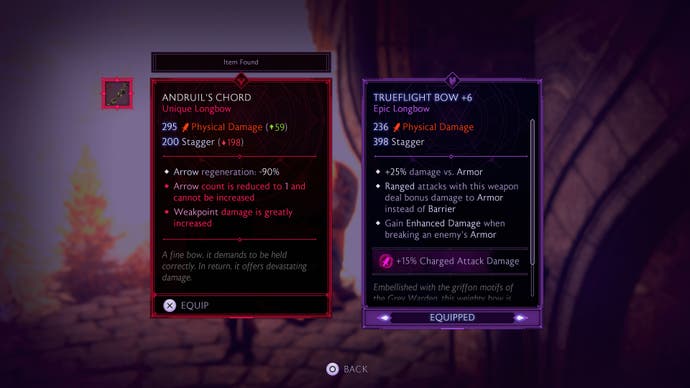
The red items are unique items, and they're powerful enough for you to alter your whole build around. I tried this bow for a while but being limited to only one shot was too punishing. | Image credit: Eurogamer / EA BioWare
Levelling up saves it. The more special abilities you unlock - such as the ability to charge up headshots and, hallelujah, briefly slow time - the more manageable it becomes. It's a wonderful, freeform system, character building: there are three specialisations for each class but everything is spread out across one big skill tree, so how you get to those specialisations is up to you. There are special abilities, button-press abilities, passive abilities: there's a lot here for a min-maxer to think about as you plot your route around the tree, and the best part is you can respec whenever you like, as many times as you like, so you can try everything out, as you can with your companions. I love the trend of games doing this.
On top of that, there's surprising build-depth lurking among your equipment. Item rarity bonuses will combine better with certain builds than others, and you can enchant equipment and even abilities to focus this further still. Then there's temporary rune buffs you can activate during battle for situational power-ups. Put all of this together and multiply it by your companions and you've got a fairly hefty theorycrafting equation. It's actually the most engrossing Dragon Age game I've played in this regard, and when you start finding build-defining unique items later on, it edges towards an experience like Diablo. I've got a flowery bow that fires three arrows at once, for example, mitigated slightly by only doing half damage, and I've also got a ring that makes all of my ability damage suddenly do fire damage. That combines brilliantly with Taash and her fire-focused abilities, and Taash and I also have abilities that prime each other's detonation effects - combo, basically - which slow time and cause huge damage. Start mixing all of that together and building around it and you've got fireworks.
That's a long way of saying that the guts of The Veilguard are really good and that it feels great to play, and that it gives you plenty to chew on. But where the game becomes truly exceptional is the ambition of the story and the moments it places you in. There are some hard decisions to make. A lot of them come later in the game but even early on, there are moments where you'll decide the fate of entire cities, then see the repercussions of that choice both in the area itself and - brilliantly - through the companion linked to it, both mechanically and narratively. A wonderful touch.
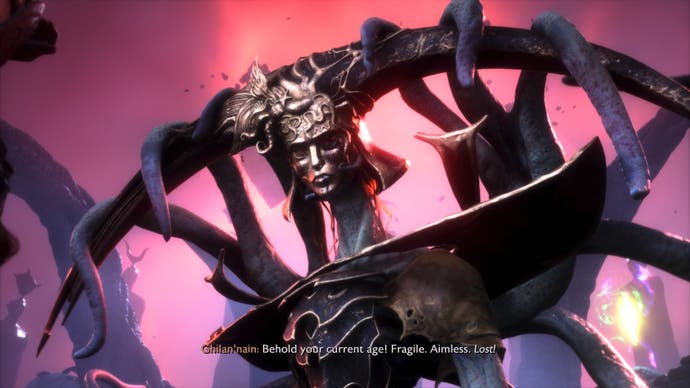
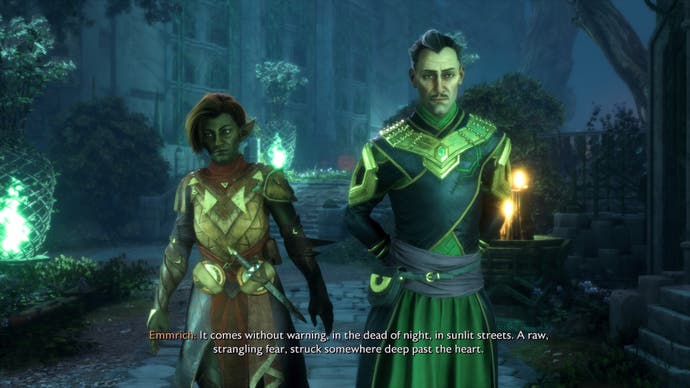
Your companions gather to talk about everything you do, which I really like. The baddies - Ghilan'nain is pictured here, are memorable too, particularly her. | Image credit: Eurogamer / EA BioWare
The villains themselves - Ghilan'nain and Elgar'nan - are a delightful pair too. Or trio, depending on how you class Solas, whose true intentions never quite seem clear. They're all brought to life majestically, Ghilan'nain as a writhing squid-like menace and Elgar'nan as larger-than-life pantomime villain. Through them, and elsewhere in the game, you will plumb the very depths of Dragon Age's lore, and learn such secrets as I've wondered for years about - where so much of this began. As an admirer of the series' lore, I feasted. There were moments I squealed at what was being revealed. It goes there; oh it goes there.
Dragon Age: The Veilguard accessibility options
Customisable difficulty options, customisable mini-map, customisable combat text, customisable subtitles, customisable depth of field, optional vignetting and motion blur, varying strengths of camera shake, multiple colour vision options, optional persistent dot, option to change hold-to-use UI inputs to tap inputs, customisable text size, and optional accessibility SFX. More detail here.
Then that ending, the all-timer. What I find so special about it, beyond just the scale and ambition of its enormously impressive cinematic spectacle, is how it brings the whole experience of The Veilguard together as a role-playing game. How it pays everything off - that time spent building faction relations, that time spent with companions, even the time spent hunting for Solas' memories in the Crossroads (where you'll find a lot of that juicy lore). Everything is honoured, everything seen and referenced, and it makes it feel so very worthwhile because of it.
What BioWare has managed to accomplish here, in the face of all the pressure it's faced since Dragon Age: Inquisition came out 10 years ago, is extraordinary. From head to toe, wing to wing, The Veilguard is exquisitely realised and full of sophistication across systems and storytelling. It's warm and welcoming, funny and hopeful, gentle when it needs to be, and of course it's epic - epic in a way I think will set a high bar not only for BioWare in years to come but for role-playing games in general. This is among the very best of them.
It is the strongest and loudest answer BioWare could have mustered for the people still doubting whether it could do it. The answer is yes, emphatically. The Veilguard is spectacular. BioWare is back.
A copy of Dragon Age: The Veilguard was supplied by EA for review.
Mortismal loves it, its his favorite DA game and his GOTY




Mortismal loves it, its his favorite DA game and his GOTY
You guys gonna have a field day on this shit lmaowielding his magic like a conductor, and Qunari dragon hunter Taash struggles with questions of identity and gender
You're too old to be saying chuds.Codex chuds


Mortismal loves it, its his favorite DA game and his GOTY

Mortismal loves it, its his favorite DA game and his GOTY
[VIDEO]




He's repeated several times in the past that Dragon Age 2 is his favorite and that the story is amazing. How some people didn't consider this a blaring warning sign in the past is beyond me.As if his credibility couldn't get any lower.
Mortismal loves it, its his favorite DA game and his GOTY
Outside of The Veliguard's moment-to-moment conversions with characters, they all start to suffer from the effect that I was worried Davrin would have. They're all largely just good people with inoffensive flaws like Bellara who blames herself for mistakes or Lucanis who can't control the demon that was forcibly put in him through no fault of his own. Nobody's a jerk (for long) or has concerning opinions about mages or anything. Good people don't make great characters. There apparently just isn't time for nuance when there are gods to fight, so every character either has an intensely personal journey with no wider ramifications or a revenge pot against an unquestionably evil person.








